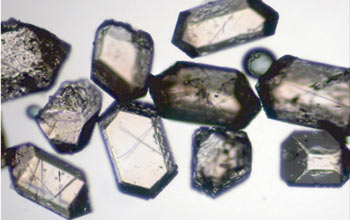News Release 05-188
New Method of Dating Oceanic Crust Is Most Accurate So Far
Discovery hinges on presence of tiny crystals called zircons
October 28, 2005
This material is available primarily for archival purposes. Telephone numbers or other contact information may be out of date; please see current contact information at media contacts.
A newly developed method that detects tiny bits of zircon in rock reliably predicts the age of ocean crust more than 99 percent of the time, making the technique the most accurate so far.
After collecting zircon-bearing samples of ocean crust, the scientists used a Sensitive High Resolution Ion Micro Probe (SHRIMP) to determine the absolute ages of 17 samples from Atlantis Bank about 75 miles south of the Southwest Indian Ridge in the southern Indian Ocean. About 25 percent of the samples were 2.5 million years older than predicted by conventional models of crust generation at mid-ocean ridges.
"This research advances our understanding of how oceanic crust is formed, and the processes involved in that formation," says Mike Cheadle, geologist at the University of Wyoming (UW) and coauthor of an article describing the technique in the Oct. 28 issue of the journal Science.
Zircons are widely regarded as providing the best basis for finding the absolute age of rocks on land, according to Cheadle's coworker, Barbara John, who is also geologist at UW. The zircon dating technique has been used extensively to answer questions such as when and how fast the Earth's continental crust forms. But until now, scientists have relied on geophysical methods based on magnetism to date ocean crust.
As the Earth's tectonic plates separate over time, new crust is created at mid-ocean ridges, says John. Minerals in the rocks that make up the crust are magnetized in the direction of the Earth's magnetic field as they cool and freeze. Because the field reverses polarity over time, the rocks record the polarity, creating alternating stripes on either side of a mid-ocean ridge.
Traditionally, instruments aboard ships have predicted the age of the ocean's crust by mapping these magnetic stripes, and then calculating an age using distance and time between polarity reversals within the crust, says Rodey Batiza, program director in the National Science Foundation (NSF)'s Division of Ocean Sciences, which funded the research. But that method does not reveal the entire process involved in the growth of ocean crust, he says.
Joshua Schwartz, the paper's first author and a UW Ph.D. candidate in geology, says the team's research offers another tool to understand the complex processes occurring beneath the Earth's surface. "Our finding that these zircons are older than they should be relative to their magnetic age alters what we've thought about oceanic crust, he says. "The ability to date zircons in ocean crust offers another and better way to determine how ocean crust is formed."
Adds Cheadle, "Findings about today's ocean ridges help us to better understand how the Earth has worked in the past."
Other co-authors of the paper are affiliated with the U.S. Geological Survey in Menlo Park, Calif., and the Woods Hole Oceanographic Institution in Woods Hole, Mass.
-NSF-
Media Contacts
Cheryl L. Dybas, NSF, (703) 292-7734, email: cdybas@nsf.gov
The U.S. National Science Foundation propels the nation forward by advancing fundamental research in all fields of science and engineering. NSF supports research and people by providing facilities, instruments and funding to support their ingenuity and sustain the U.S. as a global leader in research and innovation. With a fiscal year 2023 budget of $9.5 billion, NSF funds reach all 50 states through grants to nearly 2,000 colleges, universities and institutions. Each year, NSF receives more than 40,000 competitive proposals and makes about 11,000 new awards. Those awards include support for cooperative research with industry, Arctic and Antarctic research and operations, and U.S. participation in international scientific efforts.
Connect with us online
NSF website: nsf.gov
NSF News: nsf.gov/news
For News Media: nsf.gov/news/newsroom
Statistics: nsf.gov/statistics/
Awards database: nsf.gov/awardsearch/
Follow us on social
Twitter: twitter.com/NSF
Facebook: facebook.com/US.NSF
Instagram: instagram.com/nsfgov



